Seafood + Sauce = So Many Options
Mix and match and have a lot of fun with seafood-friendly sauces
One random thing you might not know about me yet is that I have a degree in math. Which, by the time I’d finished my studies, I really didn’t want to do anything with. Math as a career path was not meant to be. Though it does come in handy working on recipes, contemplating proportions of ingredients, scaling things up or down….that’s my kind of math.
The whole wide world of seafood recipes we might consider making is vast. Even when we pare that down to our favorite seafoods and techniques, it can be quite a long list. So here I’m paring it down a bit more, to the equation of seafood + sauce. This still can equal a wide array of delicious combinations.
And that seafood-cooking math accomplishes a couple of other things, too:
it accentuates the beauty and flavor to be had with seafoods that are cooked and served very simply
it’s an opportunity to explore types of sauces you might not have made before and/or to mix & match favorite sauces with different seafoods
it’s a fun and delicious way to reinforce how quick & easy seafood dinners can be
The “quick” of “quick & easy” comes in a few different forms:
Quickest of them all is just stirring a couple things together in a bowl. My favorite of those is yogurt with a bit of harissa stirred in; tangy, with a bit of spice. Or mayo with some lemon juice and lemon zest.
Still pretty quick is when a few things need chopping, to be stirred into mayo/sour cream/yogurt—tartar sauce is a great example. Or ingredients pulsed together in a food processor, such as pestos and the like.
A bit less quick but still in the range are sauces with ingredients that need roasting or toasting or other light prep; these might take a tad longer to make, but most can be made ahead to refrigerate until ready to serve, so dinner itself can still be quick to pull together.
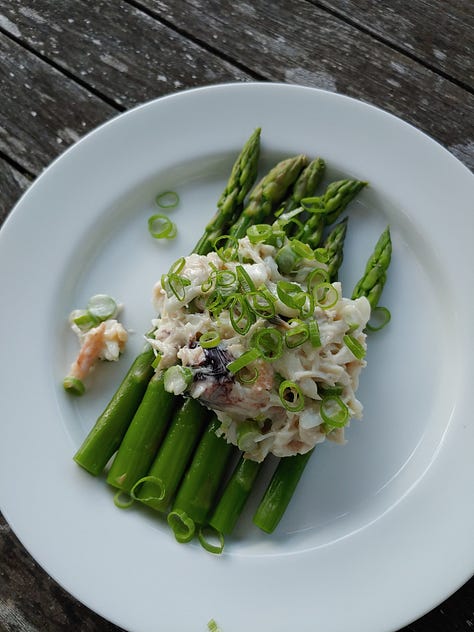

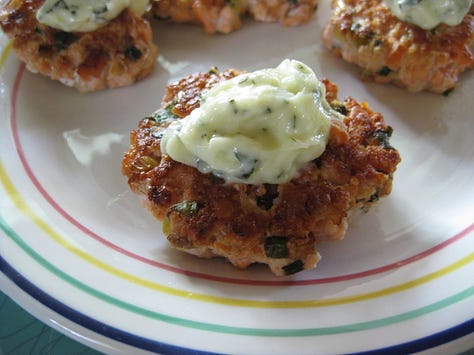
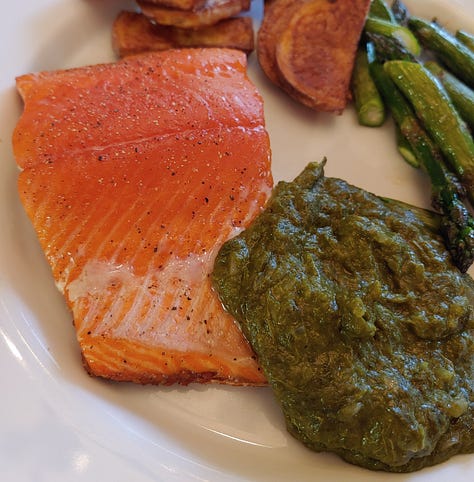

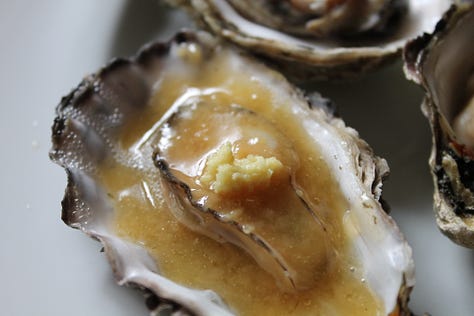
I just took a tour through recipes from past newsletters and my four seafood-focused cookbooks to remind myself of sauces I’ve paired with seafood over the years. This definitely just scratches the surface—a mere handful of the various styles and specific preparations you might consider to accompany your favorite seafoods. Here’s a taste of what I found:
from the family of mayonnaise-based sauces (sometimes made from scratch, sometimes embellishing store-bought)
good old tartar sauce, ideal for pan-fried oysters, fish sticks, other fried seafoods; I’ve made versions with pickled peppers, fresh fennel (bulb and fronds) and Old Bay seasoning, among others
simple additions of herbs and/or citrus; I’ve made a lemon mayo for cold cracked crab, lime mayo for crab fritters, basil mayo for salmon burgers
garlicy aioli or rouille (with roasted red pepper) are outstanding with so many seafood dishes; among my versions are green onion aioli for crab and asparagus salad and smoked paprika aioli for salmon with fennel
among some of so many herb-based sauces
pesto, delicious in its classic form with basil, also outstanding with other herbs and tender greens; I topped oysters with arugula-almond pesto for grilling, of course that would be great with sautéed shrimp, as base for a seafood pizza, drizzled over grilled scallops
salsa verde, which I went Italian style with (parsley, capers, garlic, thyme, vinegar) instead of the Mexican version with tomatillos, though that’s a great option as well; I made it for pan-fried softshell crab, a super versatile option when serving seafood
green goddess can cover so much territory, from traditional salad dressing to dip (made a bit thicker) to sauce for spooning over grilled or baked fish; I made a crab salad with green goddess for decadent sandwiches
sorrel can be hard to come by unless you grow your own, as I’m lucky to be able to do in my limited driveway garden; its brisk, lemony flavor is great with seafood, often paired with richer fish; sorrel cream sauce with salmon is classic
a handful of richly delicious butter-based sauces
a dill-butter sauce in which sole fillets lightly poach before the sauce is finished
a classic pan sauce: piccata, with butter, capers, lemon, here made with swordfish
to serve with grilled crab, I made a charred orange-rum butter to serve alongside for dipping
and to spoon over just-steamed-open oysters, a sake-ginger butter sauce made in the style of beurre blanc (which you’ll see more about below, in red wine form)
and last but not least, some miscellaneous sauces
mustard-horseradish sauce with stone crab claws in mind, an option for other crab or chilled shrimp or lobster
gribiche sauce (based on hard-cooked egg and cornichons) with shrimp, also great with lobster (which I did in a salad form in Shellfish)
shared below is a recipe for romesco sauce (almonds, roasted pepper, tomato), which I paired with mussels as an appetizer, though lots of options for pairing it with seafood
This is a pretty random collection of sauces but it serves as a sample of the countless possibilities for adding sauce to seafood and creating something delicious for dinner. Two of my good friends have written books that will give you far more ideas to play around with. Susan Volland wrote a reference-book-worthy title for your shelves, Mastering Sauces. Her newer Searing Inspirations has quick & easy dinners in mind, focused on pan sauces—with a full chapter of ideas for seafood. And Martha Holmberg’s Modern Sauces includes some seafood recipes, and plenty of sauce ideas you can adapt to seafood as well.
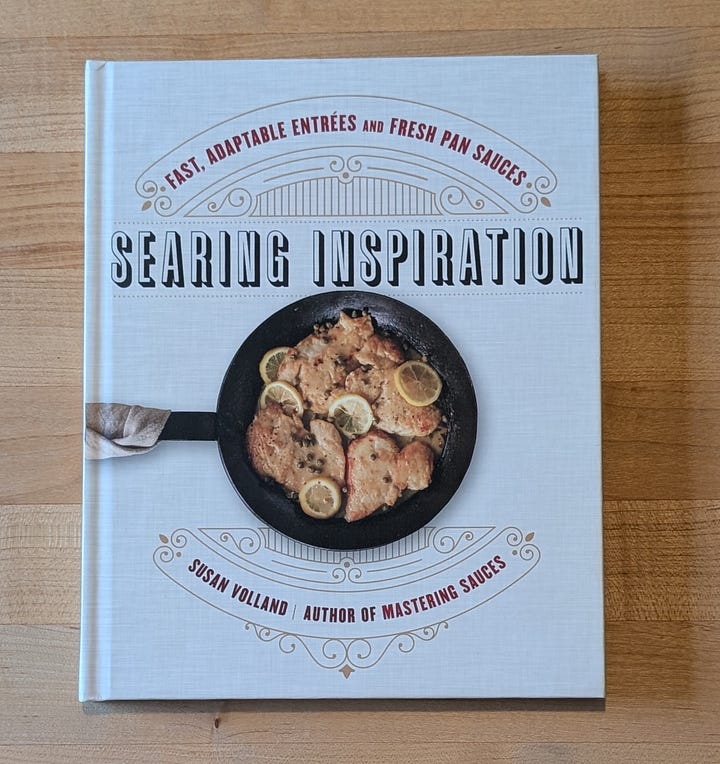
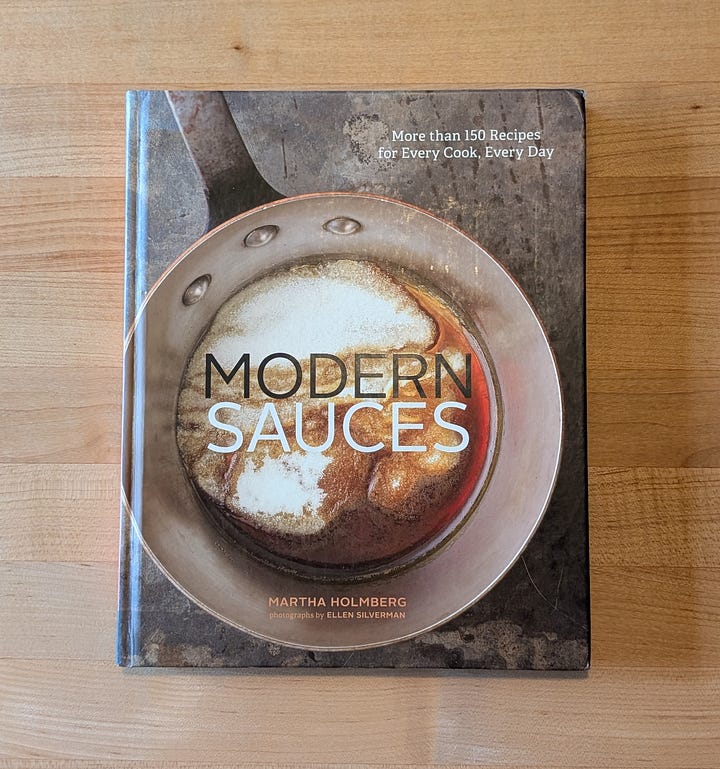
Romesco Sauce
I plucked this recipe from my Shellfish book where the sauce is the base for a crostini with mussels. To make it easier for adapting to other seafood preparations, I share here the sauce-only part of that recipe. It’s inspired by the traditional Spanish sauce, from the Catalan region. (And not to be confused with the uniquely beautiful chartreuse romanesco with its Fibonacci-number-reflecting fractal florets—more math!)
I have a hard time thinking of a seafood with which this won’t be a delicious accompaniment: most fish grilled, roasted, sautéed, or pan-seared. Tossed with shrimp or scallops. Dolloped over steamed clams. Pick your favorite and give it a try.
To recreate how I used the sauce in the cookbook, steam open a couple pounds of mussels and when cool enough to handle, take the meat out of their shells and stir it into the sauce with a bit of minced fresh thyme and/or oregano. To avoid the crostini getting soggy, I suggest having guests assemble their own; or just be sure to assemble right before serving.
1 red bell pepper
1 small tomato (about 5 ounces), halved
1/3 cup slivered almonds, toasted
2 tablespoons sherry vinegar or red wine vinegar, more to taste
1 1/2 teaspoons chopped garlic
1/4 teaspoon kosher salt, more to taste
1/4 teaspoon dried red pepper flakes, more to taste
Preheat the broiler and set the oven rack 5 to 6 inches below the element.
Put the red pepper and tomato halves (cut side down) on a rimmed baking sheet lined with foil and broil until the red pepper is tender and the skin blackens, turning the red pepper occasionally (the tomato halves just stay as is), 12 to 15 minutes. Put the pepper in a bowl and cover securely with plastic wrap, and transfer the tomato halves to a small plate; set both aside to cool.
When the pepper is cool, peel away and discard the skin, then remove the core and seeds. When the tomato is cool, peel away and discard the skin, then scoop out and discard the seeds. Dry both with paper towel to draw off excess liquid, then chop the pepper and tomato and put them in a food processor. Add the almonds, vinegar, garlic, salt, and pepper flakes and pulse until finely chopped and well blended but not quite a smooth purée; I like to leave a little texture to this sauce. Taste for seasoning, adding more salt if needed. Transfer the romesco to a medium serving bowl and set aside until ready to serve (refrigerate if made more than an hour ahead).
Makes about 1 cup sauce
Slow-Baked Salmon with Beurre Rouge
This is one of the recipes I taught in a butter-focused class this winter. Doing research and testing for that class helped prompt this newsletter in which I went deep on my love of butter. It’s a lifelong attraction I’ve had that was certainly reinforced by time in France at cooking school.
Beurre rouge is a red wine version of the classic beurre blanc sauce: wine is simmered with wine vinegar and some minced shallot until almost fully evaporated, then chilled butter is gradually whisked in so that it gently melts and creates a velvety texture. Be sure to choose a decent wine you’d be happy to drink. Lighter, younger wines are ideal; aged, full-bodied wines could be a bit much after reduction, and the finesse of the flavor is diminished in the cooking.
The lower temperature for baking the salmon gives you about 15 minutes to make the sauce, which should be plenty, and allows both to be done about the same time. You can instead make the sauce first, take it off the heat when done and very gently reheat before serving or keep it warm over warm water.
4 salmon fillet pieces (6-7 ounces each), skin and pin bones removed
Kosher salt
Beurre Rouge
1/2 cup dry red wine (such as merlot, syrah, pinot noir)
1 tablespoon red wine vinegar
2 tablespoons minced shallot
1/2 cup unsalted butter, cut into small cubes and chilled
Preheat the oven to 275 F. Line a rimmed baking sheet with parchment paper or foil and lightly oil the paper or foil. Set the salmon on the baking sheet, season lightly with salt, and bake until just a touch of translucence remains at the center of the thickest part, about 15 minutes.
For the sauce, combine the wine, vinegar, and shallot in a small heavy saucepan, bring to a boil over medium-high heat, and continue to boil until there is about 1 tablespoon of liquid remaining, 3 to 5 minutes. Reduce the heat to low and begin adding the butter a few pieces at a time, constantly whisking between each addition so the cold butter melts slowly and creates a creamy sauce. Take the pan off the heat as needed to avoid overheating the sauce, which will cause the butter to “break” and the sauce to become oily. When all the butter has been added, whisk in salt to taste. If not serving immediately, keep the sauce warm over very low heat until ready to serve; or set aside and very gently reheat before serving.
To serve, transfer the salmon fillet pieces to individual warmed plates, spoon the beurre rouge over, and serve right away.
Makes 4 servings





